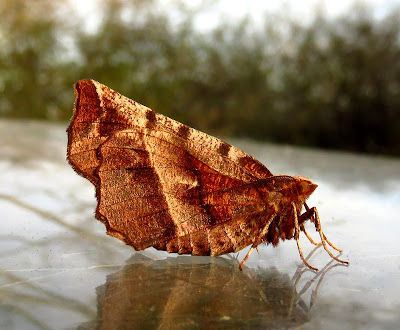There was the nice sight of a pair of avocets on the grazing fields at the country park on Thursday 14th. They were feeding in the main pool first thing in the morning but soon left and didn't return. A couple of years ago a pair bred on this main pool, so it will be interesting to see if they try here again.
One of several chiffchaffs at the park singing from the tops of trees and bushes.
Two whitethroats were heard singing for the first time this spring in the park, along their usual hedgelines on Thursday.
Also a pair of Mediterranean gulls and a yellow wagtail flew over the park calling.
Three adders were reported at the park on Thursday.
There seems to be possibly three pairs of long-tailed tits in various corners of the park, this one perched up along the horseride.
The heavens opened on Friday afternoon dumping an inch of rain on East Mersea according to Peter Mann's measurements in Shop Lane. This follows on from the other inch that fell on Tuesday.
This park path along the cliff-top pictured above, was completely flooded in places by the end of the Friday afternoon. Seeing a reed bunting singing beside this path in the morning was unexpected but maybe it knew the path would be more wetland than woodland after the deluge.
Three willow warblers were heard singing at the park in the morning by Andy Field. Three blackcaps, a whitethroat and 3 swallows were also noted at the park, while two pairs of Mediterranean gulls flew over the park.
Twenty brent geese flew over the Point and fifty linnets were seen near the Golfhouse.
A weasel was reported at the park on Friday morning.
Two Arctic terns flew along the Pyefleet Channel and a sedge warbler was heard singing at Maydays farm on Friday by Martin Cock. A wheatear was seen on the Fen Farm beach by Annie Gordon.
The moth trap operated at the park on Wednesday night resulting in 45 moths by the next morning. The most colourful moth was this streamer displaying a nice lilac colouration on it. This is a fairly common moth and is recorded each spring here, its larvae feed on dog rose.
The most notable moth was this northern drab which is listed as an Essex red data book species. It is mainly found along the coast, especially saltmarshes.
The early thorn is an easily recognised moth with the wings held up like a butterfly.
Other moths noted were common quaker, small quaker, Hebrew character, red chestnut and March moth.
Other moths noted were common quaker, small quaker, Hebrew character, red chestnut and March moth.








No comments:
Post a Comment